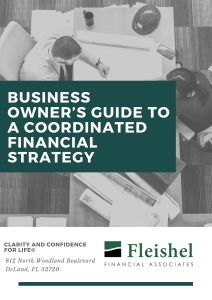When you first start a small business, the last thing you’re probably thinking about is an exit strategy, but the truth is you should be. Every small business owner or entrepreneur should start thinking about an exit strategy from the very beginning.
There are a few reasons why it’s necessary to begin planning an exit strategy so early, including:
- A lot of entrepreneur’s love getting an idea or a business off the ground, but they don’t want to stay with it for the rest of their careers. If you know now that you’re the kind of person who’s going to want to move onto something else after a while, thinking about an exit strategy from the beginning makes it easier to move onto the next thing.
- You may have investors that are expecting a significant return. This only happens if you sell the business or if the investors cash out.
- The business is not as successful or interesting as you thought it would be and you’re ready to move onto the next thing.
Don’t think about an exit strategy as a bad thing. Consider it a transition onto the next part of your life plan. You should carefully craft an exit strategy so you can leave at an optimal time without waiting for a bad situation to force you out.
Five Exit Strategies to Consider
There are many ways to leave a small business. Here are five to consider:
1. A merger or acquisition
A merger is when your business merges with a similar business, and an acquisition is when another company buys your business outright.
There are a lot of reasons to consider a merger or acquisition. For the buyer, a new acquisition is a quick way to expand, particularly when the two companies are similar enough that they can combine resources. If you’re the competition, they may be interested in buying you just to shut your down and narrow the market.
If you’re interested in a merger or acquisition as an exit strategy, you should be thinking about this from day one. Why? Because you want to make your business as attractive as possible to attract potential buyers. Small businesses are not easy to sell, and the more interest you attract, the better.
Selling to competitors is often easier. Try to identify potential buyers well in advance and shape your business with them in mind so that, when the time comes, you can justify your asking price.
2. A friendly buy-out
One of the easiest exit strategies is to sell the business to an employee or family member who understands the business and is showing a genuine interest in buying it. Employees who know they may have an option to buy you out are more likely to work harder to make the business succeed because they feel like they have a bigger stake in it. Because they already know the business, they also feel more secure about the purchase.
There are two ways to sell to employees. One is an employee ownership plan consisting of stock equity that lets employees acquire ownership in the company through stock shares. The other is a straight purchase.
There are advantages to selling to a family member, too, particularly in a situation where the long-term plan has been to pass the business on to your children. This option has many advantages, but there are some things to look out for, too. Negotiations for the sale can be awkward as you may be tempted to let your familial relationship interfere with what is best for your bottom line. Hiring a profession to negotiate and help with the sale is recommended.
3. IPO
For larger businesses, an initial public offering or IPO is the first time stock for the company is offered to the public. In some cases, this is the preferred strategy because it can be extremely profitable.
But IPOs are becoming rarer. The process is long and expensive and can require a significant upfront financial investment. You have to do a lot of compliance and reporting and produce detailed reports about staff, management, financial operations, and marketing. Plus, you may not be able to walk away at the time of the IPO. That means you may have to stick around for a while and work with shareholders, which is not always an attractive prospect for someone looking to get out of the business.
4. Liquidation
A lot of people think that liquidation means failure, but that’s not the case. Shutting down and liquidating your business by choice is a viable exit strategy, especially for a small business that relies on the skills of a single owner. With some small businesses, there isn’t a lot to sell so the process is pretty simple.
The simplicity of closing and liquidating is one of the best things about this exit strategy. You just decide when to close your doors, sell off assets, and that’s it. One of the most difficult decisions is whether or not to sell the name of the business. If it’s been around a while and has a good reputation, the business name might be worth quite a lot.
On the other hand, liquidating is often the least profitable way to exit a small business. The only money you make is from selling your assets. Selling second-hand equipment can be challenging, and you have to make sure that what you’re walking away with is enough to pay off any debts.
If you have a business with a large customer base, it’s worth trying to sell it instead of liquidating. The customer base itself is an attractive selling point for competitors or anyone looking to buy something that is more established.
5. Liquidating over time
This is an exit strategy to consider if the business has generated a lot of cash over time, and the owner has profited from taking a large salary or from dividends. The business continues to produce money until the owner decides it’s time to move on, but there are some disadvantages. For one, this strategy only works for owners who are the sole owner or stockholder. If not, there are other people to answer to who might not agree with closing the business.
If the owner takes a large salary every year, then the income tax on that money may be quite high. Alternatively, when the profit is put back into the business to raise it’s value, the higher sale price will mean more in capital gains tax.
Which is Best for You?
There’s no straightforward answer to this question since it very much depends on the owner’s personal goals and the type of business.
For example, liquidating over time and taking a large salary works for businesses like restaurants and nightclubs. If you want to make a lot of money right before you leave, an acquisition or merger is the way to go. Or, if you built your business from the ground up to build a legacy to pass down, selling it to a family member or devoted employees is the better option.
Here are some things to ask yourself when planning your exit strategy:
- What are the options for your particular business?
- Did you meet your long-term goal for the business?
- How do you see your future role?
- Why did you start this business in the first place?
- How much debt do you have?
- Do you need money quickly?
The most important thing to remember is to plan your exit strategy before something happens that forces you to make rash decisions. Don’t wait until something bad happens. Take advantage of the good situations so you can make the business as attractive as possible, whether you plan to sell it to someone else to run or liquidate it for the most profit.
Opinions expressed are those of the author and not necessarily those of Raymond James. The information has been obtained from sources considered to be reliable, but we do not guarantee that the foregoing material is accurate or complete. Any information is not a complete summary or statement of all available data necessary for making an investment decision and does not constitute a recommendation.





0 Comments